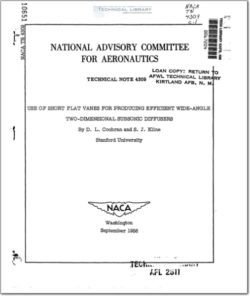NACA-TN-4309

- Version
- 239 Downloads
- 4.71 MB File Size
- 1 File Count
- December 4, 2015 Create Date
- December 4, 2015 Last Updated
National Advisory Committee for Aeronautics, Technical Notes - Use of Short Flat Vanes for Producing Efficient Wide Angle Two Dimensional Subsonic Diffusers

An investigation of the use of flat vanes in two-dimensional sub-
sonic diffusers was made. Using optimum designs of vane installations,
high pressure recoveries and steady flows were obtained for diffuser-
wall divergence angles up to #20 . Criteria for optimum configurations
were developed which indicated that the vanes should be symmetrically
arranged in the vicinity of the diffuser throat, that the vane-passage
divergence angle should be approximately 7. 0°, and that the vanes
should have a certain predictable length dependent upon the diffuser
geometry.
In virtually all systems involving the motion of fluids the need
arises to accelerate or decelerate the flow. In general, a flow accel-
eration (or nozzle process) results in a smooth flow with.high effec—
tiveness, low loss, and good velocity profiles. On the other hand,
unless considerable care is taken in the design of the passages involved,
a flow deceleration (or diffusion process) almost always results in
unsteady flows with large pulsations, large losses, and highly nonuniform
exit velocity profiles. Such a condition is not only undesirable in
itself but it also frequently creates even more undesirable effects on
the performance of downstream components such as compressors and burners.
This problem becomes particularly aggravated.when a space limitation
is present as, for example, in jet engines. Since a given deceleration
of the flow requires a given area ratio, by continuity, a compact sub—
sonic diffuser must necessarily incorporate large angles of divergence
of the walls, but such geometries are precisely those that create the
most unsteady flow, the largest losses, and the most unpredictable behav-
ior. Thus, the discovery of a means for production of wide-angle dif-
fusers of high performance, stable flow, and predictable behavior is a
problem of considerable concern. The study of a promising solution to
this problem by the use of well-designed, short, flat vanes is one of
the primary purposes of the present investigation.
| File | Action |
|---|---|
| naca-tn-4309.pdf | Download |

Comment On This Post